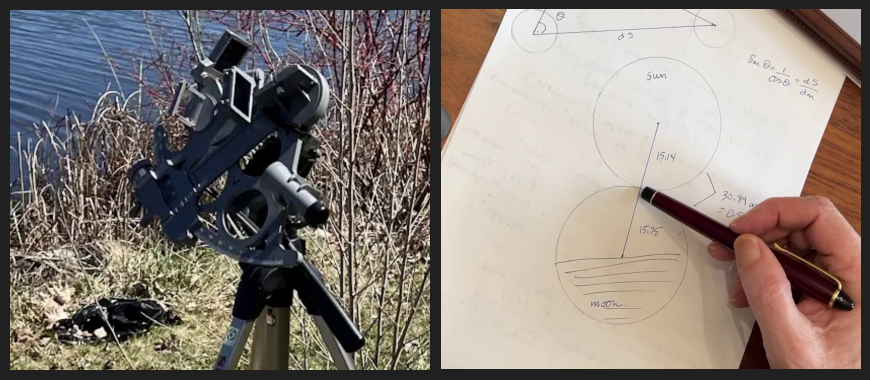
NavList:
A Community Devoted to the Preservation and Practice of Celestial Navigation and Other Methods of Traditional Wayfinding
From: Frank Reed
Date: 2024 Apr 16, 20:54 -0700
I recently started following a slide rule group on Facebook. It's just folks posting about their recent acquisitions and odd discoveries in the world of slide rules. I have only a passing interest in slide rules, so I check now and then in this group to see what's new. Today someone posted a link to a youtube video that suggests that one can determine the distance to the Sun by measuring the angle from the Moon to the Sun using a sextant. This is a variant on a proposal for determining the relative distance to the Sun that dates to Classical Greek astronomy.
The principle goes like this: You look at the Moon starting five or six days after New Moon, and you wait for the exact moment when the Moon is perfectly half full, exactly fifty percent illuminated. This is visible as the terminator (the line separating light from dark on the Moon's face) being exactly straight from pole to pole on the face of the Moon. At that time you measure the angle between the Sun and the Moon. If the Sun is very far away relative to the Moon, effectively "infinitely" far away, the measured angle will necessarily be 90°. If, at another extreme, the Sun is only, let's say, twice as far away as the Moon, then the angle from Sun to Moon will be 60°. At some intermediate relative distance the angle would of course be intermediate between 60° and 90°. Measure it, and you then determine the distance to the Sun as a multiple of the distance to the Moon. Nice. Clever Greeks. But it doesn't work.
This clever trick doesn't work because that "exact moment" when the Moon is perfectly 50.00% illuminated is not possible to judge observationally with anything remotely like useful accuracy. It's not obvious why this is so difficult until you look through a telescope and discover that the terminator has huge mountains and great plains and enormous craters. It's a jumbled mess. This limits any possible estimation of the phase to perhaps +/- a few percent, and that's of no use for the determination of distance described above. Note that even with a poorly defined terminator, this method would still work if the distance to the Sun were some small multiple of the Moon's distance (but it's not).
Incidentally, if we could estimate percent illumination of the Moon to +/-0.01% (that's a hundredth of one percent ...a very small difference), then we wouldn't need sextants for lunars. For observations for nearly a whole week centered on First or Last Quarter, a 0.01° increase in the lunar distance angle from Sun to Moon decreases the percentage illumination by very nearly a hundredth of a percent. Actual visual observation of the Moon'd phase changes is at least a hundred times lower in quality.
Back to the youtube video. Watch it here:
I can see a number of problems with this video. Anyone else see any issues? Right at the top of the list, I note that he's using a predicted time for the event of First Quarter moon, apparently the time of geocentric Moon-Sun (lunar distance) angle at 90°00.0'. This isn't really what's desired here, but more importantly, working from this predicted time makes the whole process logically circular. The observed angle if done properly will merely be consistent. At least it would be so if there were not so many problems with the analysis that follows... Anyone see the issues I'm noticing?
Frank Reed
Clockwork Mapping / ReedNavigation.com
Conanicut Island USA







